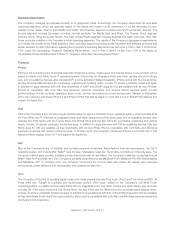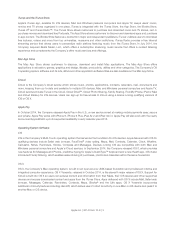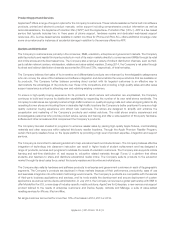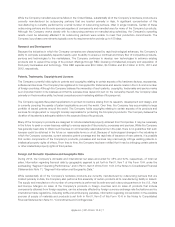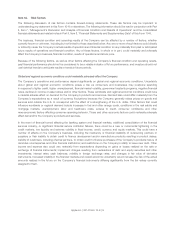Apple 2014 Annual Report Download - page 14
Download and view the complete annual report
Please find page 14 of the 2014 Apple annual report below. You can navigate through the pages in the report by either clicking on the pages listed below, or by using the keyword search tool below to find specific information within the annual report.Future operating results depend upon the Company’s ability to obtain components in sufficient quantities.
Because the Company currently obtains components from single or limited sources, the Company is subject to significant
supply and pricing risks. Many components, including those that are available from multiple sources, are at times subject to
industry-wide shortages and significant commodity pricing fluctuations. While the Company has entered into agreements for
the supply of many components, there can be no assurance that the Company will be able to extend or renew these
agreements on similar terms, or at all. A number of suppliers of components may suffer from poor financial conditions, which
can lead to business failure for the supplier or consolidation within a particular industry, further limiting the Company’s ability to
obtain sufficient quantities of components. The follow-on effects from global economic conditions on the Company’s suppliers,
described in “Global and regional economic conditions could materially adversely affect the Company” above, also could affect
the Company’s ability to obtain components.Therefore, the Company remains subject to significant risks of supply shortages
and price increases.
The Company and other participants in the markets for mobile communication and media devices and personal computers
also compete for various components with other industries that have experienced increased demand for their products. The
Company uses some custom components that are not common to the rest of these industries. The Company’s new products
often utilize custom components available from only one source. When a component or product uses new technologies, initial
capacity constraints may exist until the suppliers’ yields have matured or manufacturing capacity has increased. Continued
availability of these components at acceptable prices, or at all, may be affected if those suppliers decide to concentrate on the
production of common components instead of components customized to meet the Company’s requirements. The supply of
components for a new or existing product could be delayed or constrained, or a key manufacturing vendor could delay
shipments of completed products to the Company.
The Company depends on component and product manufacturing and logistical services provided by outsourcing
partners, many of whom are located outside of the U.S.
Substantially all of the Company’s manufacturing is performed in whole or in part by a few outsourcing partners located
primarily in Asia. The Company has also outsourced much of its transportation and logistics management. While these
arrangements may lower operating costs, they also reduce the Company’s direct control over production and distribution. It is
uncertain what effect such diminished control will have on the quality or quantity of products or services, or the Company’s
flexibility to respond to changing conditions. Although arrangements with these partners may contain provisions for warranty
expense reimbursement, the Company may remain responsible to the consumer for warranty service in the event of product
defects and could experience an unanticipated product defect or warranty liability. While the Company relies on its partners to
adhere to its supplier code of conduct, material violations of the supplier code of conduct could occur.
The Company relies on sole-sourced outsourcing partners in the U.S., Asia and Europe to supply and manufacture many critical
components, and on outsourcing partners primarily located in Asia, for final assembly of substantially all of the Company’s
hardware products. Any failure of these partners to perform may have a negative impact on the Company’s cost or supply of
components or finished goods. In addition, manufacturing or logistics in these locations or transit to final destinations may be
disrupted for a variety of reasons including, but not limited to, natural and man-made disasters, information technology system
failures, commercial disputes, military actions or economic, business, labor, environmental, public health, or political issues.
The Company has invested in manufacturing process equipment, much of which is held at certain of its outsourcing partners,
and has made prepayments to certain of its suppliers associated with long-term supply agreements. While these arrangements
help ensure the supply of components and finished goods, if these outsourcing partners or suppliers experience severe
financial problems or other disruptions in their business, the net realizable value of these assets could be negatively impacted.
The Company’s products and services may experience quality problems from time to time that can result in decreased
sales and operating margin and harm to the Company’s reputation.
The Company sells complex hardware and software products and services that can contain design and manufacturing defects.
Sophisticated operating system software and applications, such as those sold by the Company, often contain “bugs” that can
unexpectedly interfere with the software’s intended operation. The Company’s online services may from time to time
experience outages, service slowdowns, or errors. Defects may also occur in components and products the Company
purchases from third parties. There can be no assurance the Company will be able to detect and fix all defects in the hardware,
software and services it sells. Failure to do so could result in lost revenue, significant warranty and other expenses and harm to
the Company’s reputation.
Apple Inc. | 2014 Form 10-K | 12


